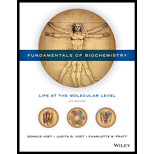
(a)
To determine: The net charge of the predominant form of Arg at pH 1.0.
Concept introduction: Each amino acid has unique ionization characteristics that vary at different pH. Ionizable groups such as amino group, carboxylic group at certain pH remain protonated, and when the pH increases, it becomes deprotonated.
(b)
To determine: The net charge of the predominant form of Arg at pH 5.0.
Concept introduction: Each amino acid has unique ionization characteristics that vary at different pH. Ionizable groups such as amino group, carboxylic group at certain pH remain protonated, and when the pH increases, it becomes deprotonated.
(c)
To determine: The net charge of the predominant form of Arg at pH 10.5.
Concept introduction: Each amino acid has unique ionization characteristics that vary at different pH. Ionizable groups such as amino group, carboxylic group at certain pH remain protonated, and when the pH increases, it becomes deprotonated.
(d)
To determine: The net charge of the predominant form of Arg at pH 13.5.
Concept introduction: Each amino acid has unique ionization characteristics that vary at different pH. Ionizable groups such as amino group, carboxylic group at certain pH remain protonated, and when the pH increases, it becomes deprotonated.
Want to see the full answer?
Check out a sample textbook solution
Chapter 4 Solutions
Fundamentals of Biochemistry: Life at the Molecular Level
- Example 1: 1. Suppose an enzyme (MW = 5,000 g/mole) has a concentration of 0.05 mg/L. If the kcat is 1 x 10 s, what is the theoretical maximum reaction velocity for the enzyme? A) 1050 µM/s. B) 100 µM/s. C) 150 μM/s. D) 105 μM/s.arrow_forwardIn 1956, E. P. Kennedy and S. B. Weiss published their study of membrane lipid phosphatidylcholine (lecithin) synthesis in rat liver. Their hypothesis was that phosphocholine joined with some cellular component to yield lecithin. In an earlier experiment, incubating 32 P-labeled phosphocholine at physiological temperature (37 °C) with broken cells from rat liver yielded labeled lecithin. This became their assay for the enzymes involved in lecithin synthesis. Determine the optimal pH for this enzyme and characterize the enzyme activity at different pH values. -O-P-O-CH2-CH₁₂-N(CH3)3 Phosphocholine H₂C-O-C-R HC-O-C-R2 + + + Cell fraction + ? HC-O-P-O-CH₁₂-CH₂-N(CH), O Phosphatidylcholine The researchers then centrifuged the broken cell preparation to separate the membranes from the soluble proteins. They tested three preparations: whole extract, membranes, and soluble proteins. Table 1 summarizes the results. Table 1: Cell fraction requirement for incorporation of 32p-phosphocholine into…arrow_forwardResearchers isolated an unknown substance, X, from rabbit muscle. They determined its structure from the following observations and experiments. (a) Qualitative analysis showed that X was composed entirely of C, H, and O. A weighed sample of X was completely oxidized and the H2O and CO2 produced were measured. This quantitative analysis revealed that X contained 40.00% C, 6.71% H, and 53.29% O by weight. (b) The molecular mass of X, as determined by mass spectrometry, was 90.00 atomic mass units (u). (c) Infrared spectroscopy showed that X contained one double bond. (d) X dissolved readily in water, and the solution demonstrated optical activity when tested in a polarimeter. (e) The aqueous solution of X is acidic. What is the empirical formula of X?arrow_forward
- Show work. don't give Ai generated solution....give correct solutionarrow_forwardBiochemistry What is the process of "transamination" in either the muscles or the liver, that involves keto acid or glutamic acid? Please explain how the steps work. Thank you!arrow_forwardBiochemistry Please help. Thank you What is the importance of glutamic acid in the metabolism of nitrogen from amino acids? (we know therole; it’s used to remove the nitrogen from amino acids so that the remaining carbon skeleton can bebroken down by the “usual” pathways, but what is the important, unique role that only glutamicacid/glutamate can do?)arrow_forward
- Biochemistry Please help. Thank you When carbamyl phosphate is joined to L-ornathine, where does the energy for the reaction come from?arrow_forwardBiochemistry Question Please help. Thank you What is the function of glutamate dehydrogenase?arrow_forwardBiochemistry Question Please help. Thank you How and why does a high protein diet affect the enzymes of the urea cycle?arrow_forward
- Biochemistry What is the importance of the glucose-alanine cycle?arrow_forwardBiochemistry Assuming 2.5 molecules of ATP per oxidation of NADH/(H+) and 1.5molecules of ATP per oxidation of FADH2, how many ATP are produced per molecule of pyruvate? Please help. Thank youarrow_forward1. How would you explain the term ‘good food’? 2. How would you define Nutrition? 3. Nutrients are generally categorised into two forms. Discuss.arrow_forward
 BiochemistryBiochemistryISBN:9781319114671Author:Lubert Stryer, Jeremy M. Berg, John L. Tymoczko, Gregory J. Gatto Jr.Publisher:W. H. Freeman
BiochemistryBiochemistryISBN:9781319114671Author:Lubert Stryer, Jeremy M. Berg, John L. Tymoczko, Gregory J. Gatto Jr.Publisher:W. H. Freeman Lehninger Principles of BiochemistryBiochemistryISBN:9781464126116Author:David L. Nelson, Michael M. CoxPublisher:W. H. Freeman
Lehninger Principles of BiochemistryBiochemistryISBN:9781464126116Author:David L. Nelson, Michael M. CoxPublisher:W. H. Freeman Fundamentals of Biochemistry: Life at the Molecul...BiochemistryISBN:9781118918401Author:Donald Voet, Judith G. Voet, Charlotte W. PrattPublisher:WILEY
Fundamentals of Biochemistry: Life at the Molecul...BiochemistryISBN:9781118918401Author:Donald Voet, Judith G. Voet, Charlotte W. PrattPublisher:WILEY BiochemistryBiochemistryISBN:9781305961135Author:Mary K. Campbell, Shawn O. Farrell, Owen M. McDougalPublisher:Cengage Learning
BiochemistryBiochemistryISBN:9781305961135Author:Mary K. Campbell, Shawn O. Farrell, Owen M. McDougalPublisher:Cengage Learning BiochemistryBiochemistryISBN:9781305577206Author:Reginald H. Garrett, Charles M. GrishamPublisher:Cengage Learning
BiochemistryBiochemistryISBN:9781305577206Author:Reginald H. Garrett, Charles M. GrishamPublisher:Cengage Learning Fundamentals of General, Organic, and Biological ...BiochemistryISBN:9780134015187Author:John E. McMurry, David S. Ballantine, Carl A. Hoeger, Virginia E. PetersonPublisher:PEARSON
Fundamentals of General, Organic, and Biological ...BiochemistryISBN:9780134015187Author:John E. McMurry, David S. Ballantine, Carl A. Hoeger, Virginia E. PetersonPublisher:PEARSON





